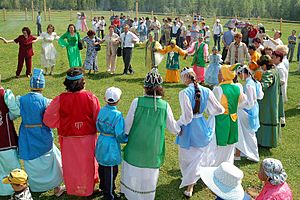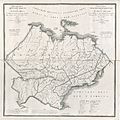Sakha Republic facts for kids
Quick facts for kids Republic of SakhaРеспублика Саха (Russian) Саха Өрөспүүбүлүкэтэ (Yakut) |
|||||
|---|---|---|---|---|---|
| — Republic — | |||||
|
|||||
|
|||||
| Political status | |||||
| Country | Russia | ||||
| Federal district | Far Eastern Federal District | ||||
| Economic region | Far Eastern Economic Region | ||||
| Established | April 27, 1922 | ||||
| Capital | Yakutsk | ||||
| Government (as of May 2018) | |||||
| • Head | Aysen Nikolayev | ||||
| • Legislature | Il Tumen (State Assembly) | ||||
| Statistics | |||||
| Area (as of the 2002 Census) | |||||
| • Total | 3,083,523 km2 (1,190,555 sq mi) | ||||
| Area rank | 1st | ||||
| Population (2010 Census) | |||||
| • Total | 958,528 | ||||
| • Rank | 55th | ||||
| • Density | 0.31/km2 (0.80/sq mi) | ||||
| ISO 3166-2 | RU-SA | ||||
| License plates | 14 | ||||
| Official languages | Russian; Yakut, Yukaghir | ||||
| Official website: http://sakha.gov.ru/ | |||||
The Republic of Sakha is a huge area in Siberia, Russia. It is one of Russia's 85 main regions, called federal subjects of Russia. Sakha is part of the Far Eastern District, which includes ten other regions.
Sakha is the largest federal subject in all of Russia! It's so big that it covers three different time zones. You might also hear this area called Yakutia.
Contents
History of Sakha
Long ago, small groups of native people lived in Yakutia. They hunted to find food and survive. Around the 13th and 14th centuries, a group called the Yakuts started moving north from Lake Baikal. Most of the Yakuts settled on the lands of these native tribes.
The Yakuts were special because they raised cattle and horses. They were also skilled at blacksmith work. These skills helped them stay in one place for longer. In the 17th century, Russians from Europe arrived in the region. The Yakut tribes, led by King Tygyn Darkhan, tried to fight the Russians. But the Yakuts did not have guns, so they lost.
The Russians took control of the Yakuts' land and kept moving east. Years later, many people were sent to live in Yakutia as a punishment. This was because Yakutia was very far away from other places.
Between 1921 and 1923, during the Russian Civil War, Yakutia was the last area controlled by the White Russians. Eventually, the Bolsheviks' Red Army took control. This event is known as the Yakut Revolt.
Later, under Stalin, special camps were built in the area. People were sent there to work, often mining gold. This gold helped the Soviet Union grow its industries. After the Soviet Union ended, Yakutia became the Republic of Sakha. It is still a republic within Russia today.
Geography and Climate
Sakha is in the northern part of Eastern Siberia. Because it is so large, it has two main climates: polar tundra and subarctic. Both climates have very long, cold winters and short, mild summers. There isn't much rain in this region.
The tundra climate in northern Sakha means the land is mostly empty and frozen. The subarctic climate in southern Sakha allows for taiga forests. These forests are home to many animals and birds.
Sakha also has several mountain ranges. The Lena Pillars are amazing rock formations found here. They are so special that they are a UNESCO World Heritage Site. The region is also rich in valuable minerals like diamonds, gold, and coal. Sakha is famous for its extreme temperatures. In winter, it can get as cold as −71.2 °C (−96.2 °F). In summer, it can be as hot as 40.7 °C (105.3 °F)!
People of Sakha (Demographics)
After the Soviet Union ended, Sakha's population went down for a while. But now, it is growing again! More than half of the people live in cities and towns. Most of them live in the capital city, Yakutsk.
About half of the people in Sakha are ethnic Yakuts. Most of the other half are Russians. Most people in Sakha follow Orthodox Christianity or do not believe in any religion. Some ethnic Yakuts still practice Shamanism. This is a belief system that respects spirits and nature. More native people are becoming interested in Shamanism again.
Russian is taught and used a lot in Sakha. But the Yakut language is also common. Different native tribes use Yakut to talk to each other. Yakut is also taught in some schools and spoken at home.
Culture and Traditions
The Olonkho is a famous Yakut story. It tells tales about great heroes, animals, and even everyday problems. Only experts who have learned the very long story well can perform it.
The Olonkho is part of the UNESCO Representative List of Intangible Cultural Heritage of Humanity. This means it's a very important story that needs to be remembered and shared.
Republic Day is celebrated every year on April 27. It marks the day in 1922 when Yakut ASSR was formed during the Soviet Union. The Yhyаkh festival happens between June 10 and 25 each year. It is one of two New Year's Day celebrations for the Yakut people. The other is the more common New Year's Day in January. Yhyаkh celebrates the start of the short summer season.
Economy and Resources
Sakha's economy mainly depends on mining. They dig up minerals like diamonds, gold, tin, and coal. Sakha is Russia's biggest producer of minerals and raw materials. It also produces 99% of Russia's diamonds! This is about a quarter of all the diamonds in the world.
Other important industries in Sakha include making construction materials, jewelry, and medicine. In contrast, many native Yakut people still raise cattle and horses. They also hunt and fish to provide for themselves.
Government and Politics
The Head of Sakha is the main leader of the republic. People vote for the Head every five years. The Il Tumen, also known as the State Assembly, is the republic's parliament. Its members are also chosen by public vote every five years. Most of the lawmakers in the Il Tumen are currently from the United Russia party. This party is the main ruling party in Russia.
Transportation and Travel
Sakha is north of the important Trans-Siberian railway and Trans-Siberian Highway. This means it's a bit far from Russia's main travel routes. The main roads in Sakha are the Lena Highway, which goes south, and the Kolyma Highway, which goes east.
These roads are usually open all year. However, there is no bridge across the Lena River. So, cars have to take a ferry across the river in summer. In winter, they can drive right on the ice! The Amur-Yakutsk train line connects Sakha to the rest of the Trans-Siberian railway.
Sakha has several airports, including the Yakutsk International Airport. Flights from these airports connect Sakha to cities far away. It's also possible to transport goods using the Northern Sea Route during certain times of the year.
Images for kids
-
Fauna of the Sakha Republic: Ross's gull, the Siberian crane, polar bear, horse and reindeer. Russian post miniature sheet, 2006.
-
British explorer & missionary Kate Marsden in Yakutsk, 1891.
See also
 In Spanish: Sajá para niños
In Spanish: Sajá para niños





























